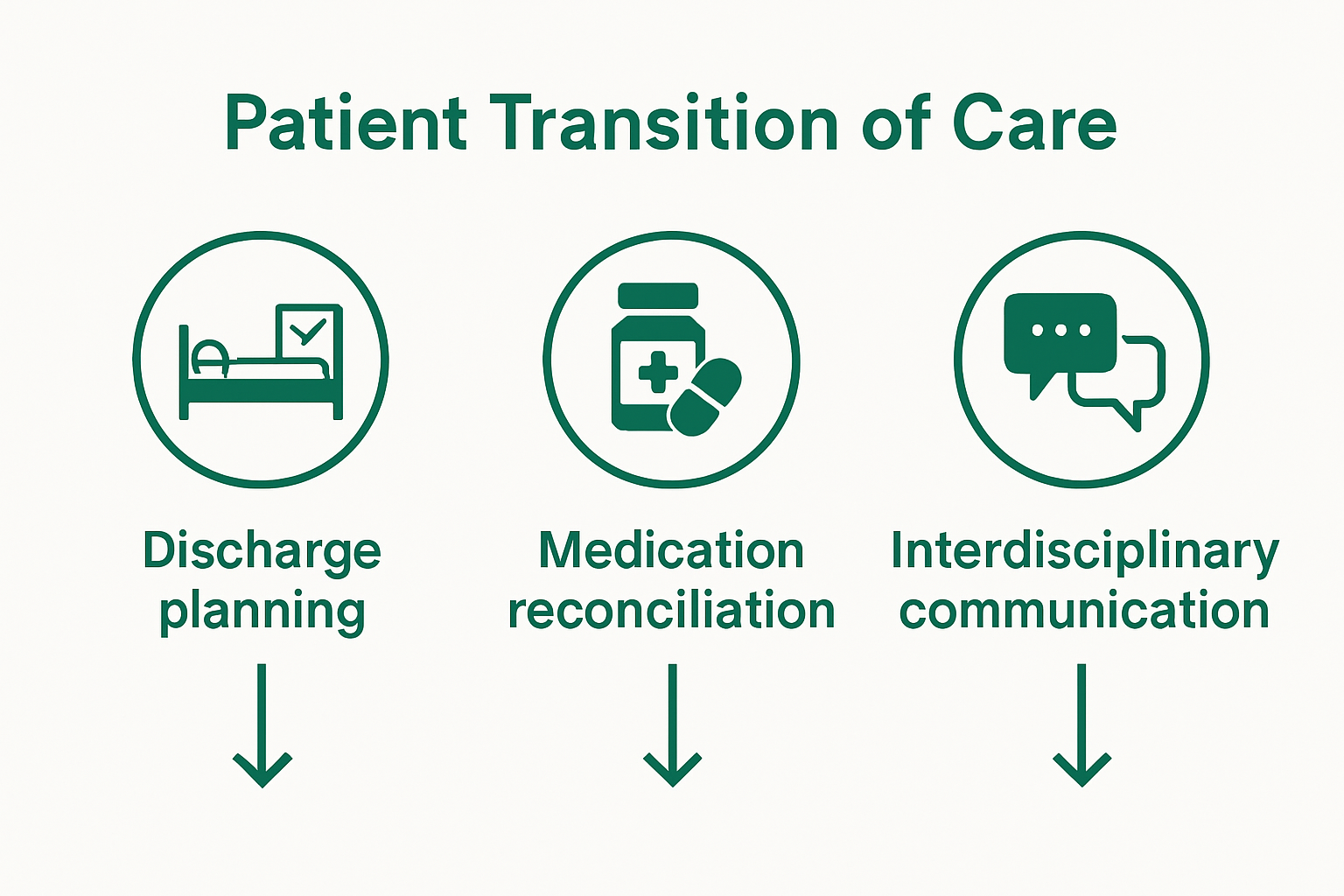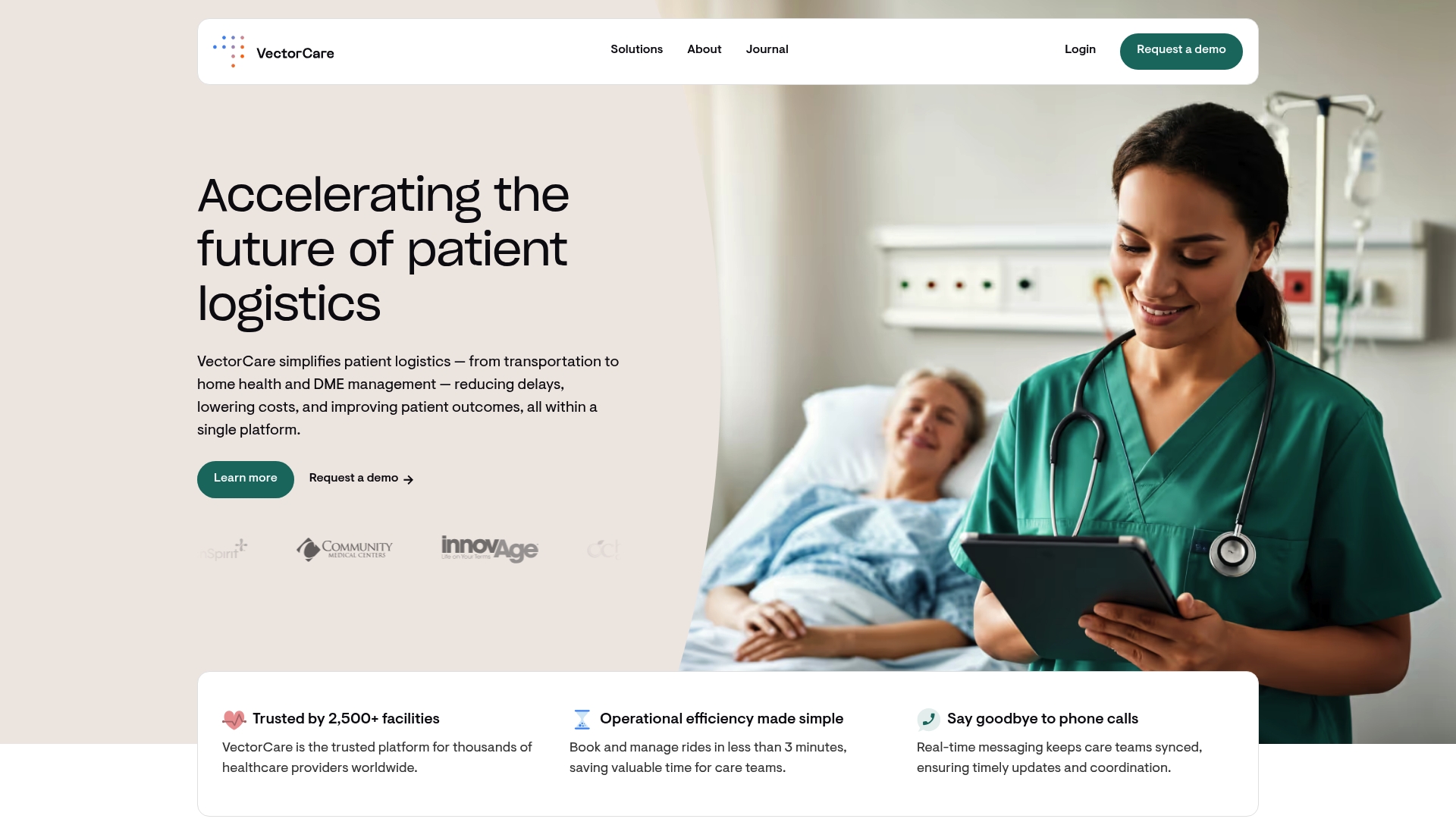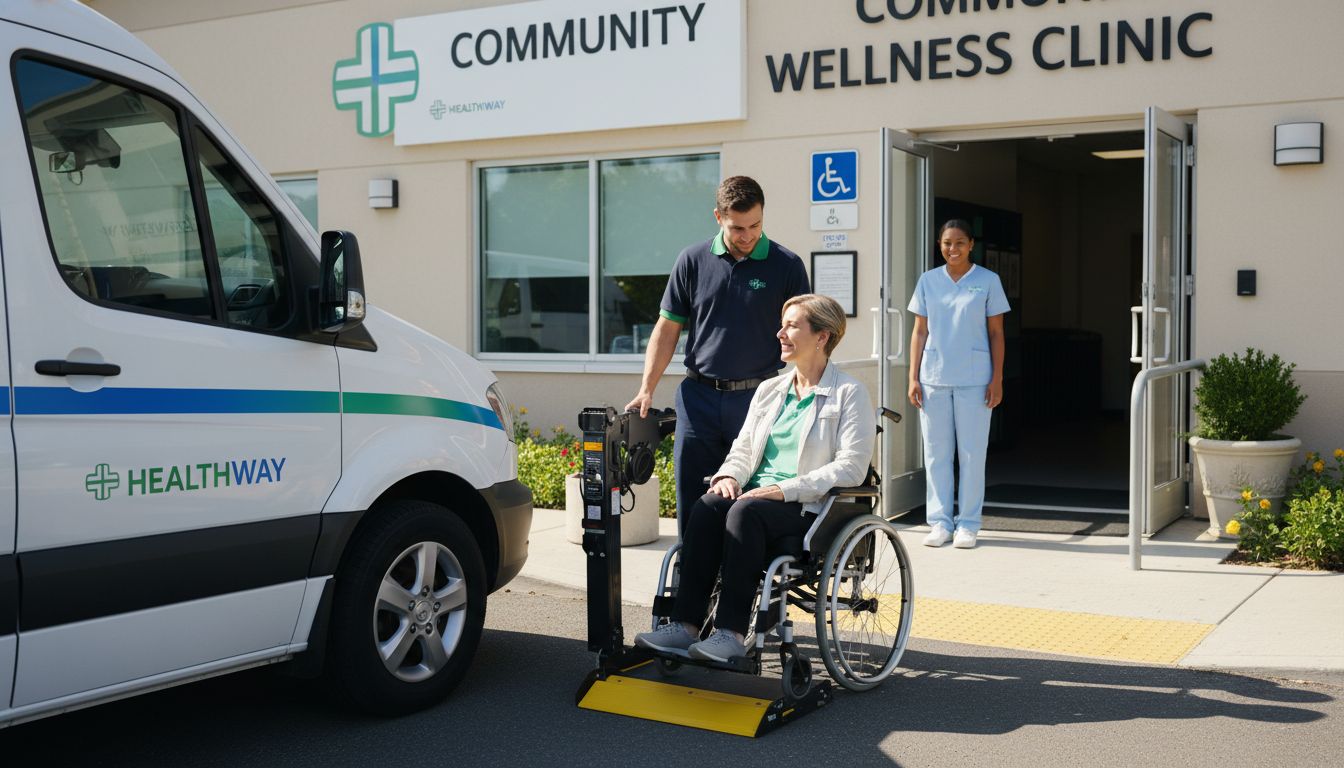Patient Transition of Care Best Practices for 2025 Providers

Patient transitions are make-or-break moments in healthcare. Studies show that nearly 80 percent of serious medical errors involve miscommunication during patient handoffs. Yet most people assume smooth transitions are just about getting the paperwork right. In reality, the biggest improvements come from empowering both patients and care teams with smarter planning, stronger communication, and hands-on engagement that drive real results.
Table of Contents
- Key Steps in Patient Transition of Care
- Roles and Responsibilities Across Healthcare Teams
- Improving Communication and Reducing Errors
- Best Practices for Special Patient Populations
Quick Summary
| Takeaway | Explanation |
|---|---|
| Involve Patients in Discharge Planning | Engage patients and families as partners in their own discharge process to improve understanding and adherence to care plans. |
| Implement Medication Reconciliation Thoroughly | Review and confirm comprehensive medication lists to avoid errors and ensure patient safety during transitions. |
| Standardize Communication Protocols Across Teams | Use structured communication methods like SBAR to enhance information transfer and minimize misunderstandings among healthcare providers. |
| Focus on Care Coordination for Vulnerable Populations | Tailor transition plans for special patient groups, considering medical, social, and psychological factors to improve outcomes. |
| Invest in Continuous Staff Education | Regular training on communication and care transition practices unifies team members and reduces potential errors during patient handoffs. |
Key Steps in Patient Transition of Care
Patient transition of care represents a critical healthcare process that demands precision, communication, and strategic coordination to ensure seamless medical handoffs and optimal patient outcomes. Effective transitions minimize risks, reduce potential medical errors, and support continuous patient care across different healthcare settings.
Comprehensive Discharge Planning
Discharge planning is the cornerstone of successful patient transitions. Learn more about patient flow strategies that can transform hospital efficiency. According to the Agency for Healthcare Research and Quality, the IDEAL discharge planning strategy provides a robust framework for healthcare providers. This approach emphasizes patient and family engagement as full partners in the discharge process.
The IDEAL strategy involves several critical components. First, healthcare providers must involve patients and their families directly in discharge planning. This means creating a collaborative environment where patients understand their post-discharge care requirements. Second, providers need to discuss potential challenges patients might encounter after leaving the hospital, anticipating and mitigating potential complications.
Communication during discharge must be clear, concise, and tailored to the patient’s health literacy level. Providers should use plain language and verify patient understanding through teach-back methods. This approach ensures patients comprehend medication instructions, follow-up appointments, and potential warning signs that require immediate medical attention.
Medication Reconciliation
Medication reconciliation is another crucial step in patient transition of care. Research from AHRQ’s Patient Safety Network highlights the significant risks associated with medication errors during care transitions. Healthcare providers must meticulously review and communicate a patient’s complete medication list, including dosages, frequencies, and potential interactions.
The process involves comparing the patient’s current medication regimen with newly prescribed treatments, ensuring no duplications or contraindications exist. This step is particularly critical for patients with complex medical histories or those managing multiple chronic conditions. Electronic health record systems can support this process by providing comprehensive medication histories and automatic interaction alerts.
Care Coordination and Communication
Effective care coordination requires seamless communication between different healthcare providers and settings. This involves creating detailed transfer documents, establishing clear communication protocols, and ensuring all healthcare team members have access to comprehensive patient information.
Healthcare providers should implement standardized communication tools that capture essential patient information, including medical history, current treatment plans, medication lists, and specific care instructions. Digital platforms that enable real-time information sharing can significantly enhance the transition process, reducing the likelihood of miscommunication or overlooked critical details.
Successful patient transitions demand a holistic approach that prioritizes patient engagement, thorough documentation, and collaborative communication. By implementing these key steps, healthcare providers can create a more reliable, safe, and patient-centered transition of care process that minimizes risks and supports optimal health outcomes.

Roles and Responsibilities Across Healthcare Teams
Patient transition of care requires a collaborative and synchronized approach across multiple healthcare professionals, each playing a critical role in ensuring comprehensive and safe patient handoffs. Understanding these distinct yet interconnected roles is essential for creating a seamless continuum of care.
Physician and Specialist Coordination
Learn more about professional collaboration strategies that enhance patient care. According to the Agency for Healthcare Research and Quality, effective physician and specialist coordination is fundamental to successful patient transitions. Primary care physicians must develop comprehensive discharge summaries that provide detailed medical histories, treatment plans, and specific care instructions for specialists and follow-up providers.
Specialists play a crucial role in communicating complex medical interventions and treatment nuances. They must ensure that primary care providers receive detailed reports about specialized treatments, potential complications, and recommended monitoring protocols. This information exchange helps create a holistic understanding of the patient’s medical needs across different healthcare settings.
Nursing and Care Management
Nurses serve as critical communication bridges during patient transitions. AHRQ’s Patient Safety Network emphasizes the importance of standardized communication tools like the I-PASS handoff protocol to enhance information transfer and reduce potential risks. Nurses are responsible for verifying patient understanding of discharge instructions, medication regimens, and follow-up care requirements.
Case managers coordinate complex patient transitions, particularly for individuals with chronic conditions or those requiring multidisciplinary care. They work closely with physicians, nurses, and other healthcare professionals to develop comprehensive transition plans that address medical, social, and logistical challenges. Their role involves identifying potential barriers to successful transitions and proactively developing strategies to mitigate these risks.
Pharmacists and Medication Management
Pharmacists are essential team members in patient transition processes. Research from AHRQ highlights their critical role in medication reconciliation, ensuring accurate medication lists and identifying potential drug interactions or contraindications during care transitions.
Their responsibilities include reviewing medication histories, verifying new prescriptions, and providing patient education about medication management. Pharmacists collaborate with physicians and nurses to create comprehensive medication transition plans that minimize the risk of adverse drug events and support patient adherence to prescribed treatments.
Successful patient transitions depend on clear, collaborative communication and well-defined roles across healthcare teams. By establishing robust communication protocols, leveraging technology, and maintaining a patient-centered approach, healthcare professionals can create more reliable and effective care transition processes that prioritize patient safety and continuity of care.
To clarify the roles of various care team members during patient transitions, the table below organizes their key responsibilities:
| Role | Key Responsibilities |
|---|---|
| Physician | Create detailed discharge summaries, communicate care plans, relay treatment history to specialists and follow-up providers |
| Specialist | Share updates and treatment plans, highlight complications, recommend monitoring protocols |
| Nurse | Verify patient understanding, facilitate I-PASS communication, ensure smooth handoffs |
| Case Manager | Coordinate multi-disciplinary transitions, develop comprehensive transition plans, address barriers |
| Pharmacist | Conduct medication reconciliation, review/verify prescriptions, provide medication education |
Improving Communication and Reducing Errors
Effective communication is the cornerstone of safe and reliable patient transitions, serving as a critical mechanism for preventing medical errors and ensuring continuous, high-quality care. Healthcare organizations must implement strategic approaches to minimize communication gaps and enhance information transfer across different care settings.
Standardized Communication Protocols
Explore strategies for bridging communication gaps in healthcare settings. According to research published in PubMed, communication errors represent a leading source of adverse events during patient transitions. Implementing high-reliability communication principles can significantly reduce these risks.
Healthcare teams should adopt standardized communication frameworks like the SBAR (Situation-Background-Assessment-Recommendation) technique. This structured approach ensures that critical patient information is communicated consistently and comprehensively. By providing a predictable communication format, healthcare professionals can minimize misunderstandings and reduce the potential for critical information being overlooked during patient handoffs.
Digital communication tools and electronic health record systems play a crucial role in standardizing information transfer. These technologies enable real-time updates, create comprehensive patient profiles, and provide immediate access to critical medical histories, current treatments, and specific care instructions across different healthcare teams and settings.
Medication Error Prevention
Medication errors pose a significant risk during patient transitions. Research from the Agency for Healthcare Research and Quality emphasizes the importance of robust medication reconciliation protocols to prevent adverse drug events.
Healthcare organizations should implement comprehensive medication review processes that involve multiple professionals. This includes pharmacists conducting thorough medication history reviews, physicians verifying current prescriptions, and nurses confirming patient understanding of medication instructions. Advanced electronic systems can provide automatic interaction alerts and flag potential contraindications, adding an additional layer of safety.
Continuous Education and Training
Ongoing professional education is essential for improving communication and reducing errors during patient transitions. Healthcare organizations must invest in regular training programs that focus on communication skills, error prevention strategies, and the latest technological tools for information sharing.
Simulation-based training can help healthcare professionals practice complex communication scenarios, allowing them to develop skills in managing challenging patient transition situations. These training sessions should emphasize interdisciplinary collaboration, teaching professionals how to effectively communicate across different roles and specialties.
Reducing errors and improving communication requires a multifaceted approach that combines technological solutions, standardized protocols, comprehensive training, and a culture of safety. By prioritizing clear, consistent, and comprehensive communication, healthcare providers can significantly enhance patient outcomes and minimize the risks associated with care transitions.
The following table summarizes key communication protocols and tools mentioned for safe patient transitions:
| Communication Tool | Purpose | Example/Benefit |
|---|---|---|
| SBAR Framework | Standardizes handoff communication | Ensures complete transfer of critical info |
| I-PASS Protocol | Enhances nurse handoff communication | Reduces information loss during shift change |
| Electronic Health Record Systems | Real-time info sharing, documentation | Provides access to full patient history |
| Teach-Back Methods | Verifies patient understanding | Confirms adherence to discharge instructions |
Best Practices for Special Patient Populations
Patient transitions require nuanced, personalized approaches when addressing special populations with unique healthcare needs. Understanding and implementing targeted strategies can significantly improve care continuity, patient outcomes, and overall healthcare experience for vulnerable patient groups.
Pediatric and Adolescent Transitions
Explore tools for improving patient outcomes across diverse patient populations. According to the Massachusetts Department of Public Health, successful pediatric and adolescent care transitions demand comprehensive, proactive planning. Healthcare providers must begin transition planning early, focusing on developing self-management skills and gradually transferring medical decision-making responsibilities to young patients.
Key strategies include conducting regular assessments of the patient’s readiness for independent healthcare management, engaging adolescents in their own care planning, and helping them identify appropriate adult healthcare providers. Providers should create individualized transition plans that address medical, psychological, and social aspects of patient care, ensuring a smooth progression from pediatric to adult healthcare settings.
Geriatric and Chronic Condition Management
Transitioning care for elderly patients and those with complex chronic conditions requires a holistic, interdisciplinary approach. Research from the Agency for Healthcare Research and Quality highlights the importance of whole-person transitional care, particularly for adult Medicaid patients with multiple healthcare needs.
Healthcare teams should implement comprehensive care coordination strategies that include:
- Detailed medication reconciliation
- Social determinants of health assessment
- Family and caregiver involvement
- Comprehensive discharge planning
- Robust follow-up mechanisms
Technology and data analysis play crucial roles in identifying high-risk patients and developing targeted intervention strategies. Providers must focus on creating personalized care plans that address not just medical requirements, but also social support, mental health, and potential barriers to effective care management.
Vulnerable and High-Risk Populations
Patients with complex medical histories, limited healthcare access, or significant socioeconomic challenges require specialized transition approaches. A consensus policy statement by multiple medical societies emphasizes the need for standardized metrics and national standards to improve patient outcomes during care transitions.
Healthcare providers should develop culturally sensitive, patient-centered transition protocols that consider individual patient backgrounds, communication needs, and potential systemic barriers. This might involve:
- Multilingual communication support
- Community health worker engagement
- Transportation assistance
- Financial counseling
- Coordination with social services
Successful transitions for special patient populations demand a comprehensive, empathetic approach that goes beyond traditional medical care. By recognizing and addressing the unique challenges faced by different patient groups, healthcare providers can create more effective, personalized transition strategies that improve overall patient outcomes and healthcare experiences.

Frequently Asked Questions
What are the key steps in patient transition of care?
The key steps in patient transition of care include comprehensive discharge planning, medication reconciliation, and effective care coordination and communication among healthcare teams to ensure seamless handoffs and optimal patient outcomes.
How can healthcare providers improve medication reconciliation?
Healthcare providers can improve medication reconciliation by meticulously reviewing a patient’s complete medication list, ensuring accurate documentation of dosages and frequencies, and utilizing electronic health record systems to track potential interactions and alerts.
What role do pharmacists play in patient transitions?
Pharmacists play a critical role in patient transitions by conducting medication reconciliation, verifying prescriptions, and providing education on medication management to minimize medication errors and enhance patient adherence to care plans.
What best practices should be followed for vulnerable patient populations?
Best practices for vulnerable patient populations include tailoring transition plans that address medical, social, and psychological needs, engaging patients in their care, and coordinating with community resources to overcome barriers and improve health outcomes.
Seamless Care Transitions Start with the Right Digital Tools
Reducing errors during patient handoffs and improving communication are some of the biggest challenges highlighted in our exploration of patient transition of care best practices. Miscommunication, medication errors, and uncoordinated logistics consistently put patients at risk and drain provider resources. To drive real change, you need more than a checklist—you need a platform that supports every step of the transition process.

Imagine a digital solution where discharge planning, care coordination, and real-time updates come together to eliminate gaps at every handoff. With VectorCare’s platform, you get powerful tools for streamlined patient logistics, automated scheduling, and secure communication among all care team members. Discover how you can lower delays, cut administrative hassle, and achieve better patient outcomes. Take action now—explore VectorCare to see how you can modernize your patient transition process and deliver safer, more connected care.
Recommended
- Patient Flow Barriers: Impact to Hospital Efficiency and Patient Outcomes – VectorCare
- 2020 Healthcare Recap & Upcoming Care Trends – VectorCare
- Becker’s Healthcare Report: How VectorCare Solves Communication Gaps in Patient Transfers – VectorCare
- Common Credentialing Hurdles: Turn Risk Into Reliability – VectorCare



